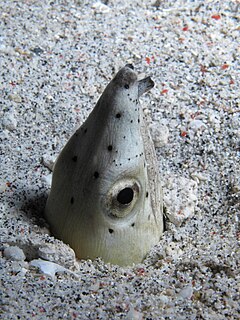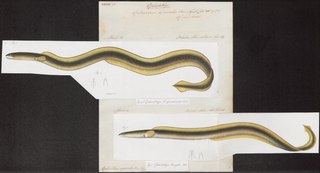
Ophichthus is a genus of eels in the snake eel family Ophichthidae.
Ariosoma obud is an eel in the family Congridae. It was described by Albert William Herre in 1923. It is a tropical, marine eel which is known from the Philippines, in the western central Pacific Ocean.
Heteroconger chapmani is an eel in the family Congridae. It was described by Albert William Herre in 1923. It is a marine, tropical eel which is known from a single specimen collected from the Philippines, in the western central Pacific Ocean. The holotype specimen measured 69 cm. The species is now considered unidentifiable due to the lack of detail in the author's description, and because the only known specimen was destroyed during World War II.
Lamnostoma taylori is an eel in the family Ophichthidae. It was described by Albert William Herre in 1923, originally under the genus Caecula. It is a tropical, freshwater eel which is known from the Philippines in Asia, where it inhabits rivers near the sea. Males can reach a maximum standard length of 16.4 centimetres (6.5 in).

The highfin snake eel (Ophichthus altipennis, also known as the blackfin snake eel or the black-finned snake eel, is an eel in the family Ophichthidae. It was described by Johann Jakob Kaup in 1856, originally under the genus Microdonophis. It is a marine, tropical eel known from the eastern Indian Ocean and northwestern and western central Pacific Ocean, including Australia, French Polynesia, Indonesia, Japan, the Marshall Islands, Malaysia, the Philippines, and Papua New Guinea. It dwells at a depth range of 0 to 40 m, and forms burrows in soft inshore sand sediments. Males can reach a maximum total length of 103 cm.

The bluntnose snake-eel is an eel in the family Ophichthidae. The author of the species is anonymous, but it has been referred to Edward Turner Bennett in 1830. It is a tropical, marine eel which is known from the Indo-Pacific, including Kenya, Madagascar, South Africa, Taiwan, Thailand, and the Philippines. It dwells at a maximum depth of 22 m, but also frequents shores. Males can reach a maximum total length of 45 cm.

The dark-shouldered snake eel is an eel in the family Ophichthidae. It was described by Pieter Bleeker in 1864. It is a tropical, marine eel which is known from the Pacific Ocean, including the East Indies, the Society Islands, the Mariana Islands, Queensland, the Marshall Islands, Micronesia, Japan, and India. It dwells at a depth range of 2–15 metres, and inhabits reefs. It forms burrows in mud and sand, and forages during the night. Males can reach a maximum total length of 115 centimetres.
The Dusky snake eel is an eel in the family Ophichthidae. It was described by Camillo Ranzani in 1839. It is a tropical, marine eel which is known from the western Atlantic Ocean, including Cuba and Brazil.
Ophichthus echeloides is an eel in the family Ophichthidae. It was described by Umberto D'Ancona in 1928. It is a marine, tropical eel which is known from the Gulf of Aqaba and the Red Sea, in the western Indian Ocean. Males can reach a maximum total length of 51 centimetres (20 in).
The death-banded snake-eel is an eel in the family Ophichthidae. It was described by Samuel Garman in 1899. It is a tropical, marine eel which is known from the eastern central and southeastern Pacific Ocean, including the central Gulf of California, Colombia, Costa Rica, Mexico and Panama. It dwells at a depth range of 35–760 metres, and forms burrows in sandy and muddy bottoms. Males can reach a maximum total length of 86 centimetres.
The Faintsaddled snake eel is an eel in the family Ophichthidae. It was described by John E. McCosker and Eugenia Brandt Böhlke in 1984. It is a marine, temperate water-dwelling eel which is known from the western central Atlantic Ocean. It is known to dwell at a depth of 108 meters.

The Evermann's snake eel is an eel in the family Ophichthidae. It was described by David Starr Jordan and Robert Earl Richardson in 1908. It is a marine, tropical eel which is known from the western Pacific Ocean. It inhabits inshore soft bottoms.
The Longarmed snake eel is an eel in the family Ophichthidae. It was described by John E. McCosker and Richard Heinrich Rosenblatt in 1998. It is a marine, tropical eel which is known from the eastern central Pacific Ocean, including Mexico, Costa Rica, El Salvador, Guatemala, Nicaragua, and Panama. It is known to dwell at a depth range of 24 to 79 metres, and inhabits soft substrates. Males can reach a maximum total length of 27.4 centimetres (10.8 in).
Ophichthus melope is an eel in the family Ophichthidae. It was described by John E. McCosker and Richard Heinrich Rosenblatt in 1998. It is a marine, tropical eel which is known from the eastern central and southeastern Pacific Ocean, including Colombia and Costa Rica. It dwells at a depth range of 100 to 224 metres. Males can reach a maximum total length of 27 centimetres (11 in).
The dottedline snake eel is a species of eels in the family Ophichthidae. It was described by John E. McCosker and Eugenia Brandt Böhlke in 1984. It is a marine, temperate water-dwelling eel which is known from the western central Atlantic Ocean. It is known to dwell at a depth of 183 meters.

The many-eyed snake-eel is a species of eel in the family Ophichthidae. It was described by Pieter Bleeker in 1864. It is a tropical, marine and freshwater-dwelling eel which is known from the Indo-Pacific, including East Africa and the Hawaiian Islands. It dwells at a depth of 2 to 25 metres, and inhabits sand and rubble sediments near coral reefs. Males can reach a total length of 62.5 centimetres (24.6 in).
The olive snake eel is an eel in the family Ophichthidae. It was described by Pieter Bleeker in 1853, originally under the genus Ophisurus. It is a marine, tropical eel which is known from the Indo-Pacific. It forms burrows in soft sediments in shallow waters, and leads a nocturnal lifestyle. Males can reach a maximum total length of 95 centimetres (37 in).
The Antillian snake eel is an eel in the family Ophichthidae. It was described by John Roxborough Norman in 1922. It is a marine, deep water-dwelling eel which is known from the western central Atlantic Ocean, including Cuba, Puerto Rico, Trinidad-Tobago, and Venezuela. It is known to dwell at a maximum depth of 300 meters, and inhabits coastal waters. Males can reach a maximum total length of 107 centimeters, but more commonly reach a TL of 70 cm.

The Manetail snake eel is an eel in the family Ophichthidae. It was described by Coenraad Jacob Temminck and Hermann Schlegel in 1846, originally under the genus Conger. It is a marine, tropical eel which is known from the Indo-Pacific. It inhabits deep waters, but is found in muddy sediments in shallow waters on rare occasions. Males can reach a maximum total length of 61.5 centimetres (24.2 in).
Pisodonophis copelandi is an eel in the family Ophichthidae. It was described by Albert William Herre in 1953. It is a marine, tropical eel which is known from the Philippines, in the western central Pacific Ocean. Males can reach a maximum standard length of 30.8 centimetres (12.1 in).




